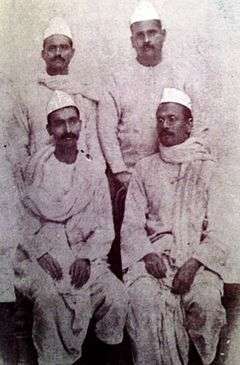Champaran Satyagraha
 (Sitting L to R) Rajendra Prasad and Anugrah Narayan Sinha, with local vakils Ramnavmi Prasad and Shambhusaran Varma (Standing L to R) during Mahatma Gandhi's 1917 Champaran Satyagraha. | |
| Date | 19 April 1917 |
|---|---|
| Location | Champaran district of Bihar, India |
| Organised by | Gandhi, Brajkishore Prasad, Rajendra Prasad, Anugrah Narayan Sinha Ramnavmi Prasad, and others including J. B. Kripalani |
The Champaran Satyagraha of 1917, in the Champaran district of Bihar, India during the period of the British Rule , was the first Satyagraha movement inspired by Mohandas Gandhi and a major revolt in the Indian Independence Movement. Another important Satyagraha just after this revolt was Kheda Satyagraha.
Champaran Satyagraha was the first to be started, but the word Satyagraha was used for the first time in Anti Rowlatt Act agitation.
Champaran is a district which comes under the state Bihar. Under Colonial era laws, many tenant farmers were forced to grow some indigo on a portion of their land as a condition of their tenancy. This indigo was used to make dye. The Germans had invented a cheaper artificial dye so the demand for indigo fell. Some tenants paid more rent in return for being let off having to grow indigo. However, during the First World War the German dye ceased to be available and so indigo became profitable again. Thus many tenants were once again forced to grow it on a portion of their land- as was required by their lease. Naturally, this created much anger and resentment.[1][2]
The crisis
Many tenants alleged that Landlords had used strong-arm tactics to exact illegal cesses and to extort them in other ways. This issue had been highlighted by a number of lawyers/politicians and there had also been a Commission of Inquiry. Ganesh shankar vidhayarthi and Peer Muneesh published the condition of Champaran in their publications because of which they lost their jobs. Raj Kumar Shukla, and Sant raut a money lender who also owned some land, persuaded Gandhi to go to Champaran and thus, the Champaran Satyagraha began. Gandhi arrived in Champaran 10 April 1917 and stay on the house of Sant raut in Amolwa village with a team of eminent lawyers: Brajkishore Prasad, Rajendra Prasad, Anugrah Narayan Sinha Ramnavmi Prasad, and others including J. B. Kripalani.[3]
Gandhi established the first-ever basic school at Barharwa Lakhansen village, 30 km east from the district headquarters at Dhaka, East Champaran, on November 13, 1917, organising scores of his veteran supporters and fresh volunteers from the region.[4] His handpicked team of eminent lawyers comprising[5] Dr.Rajendra Prasad, Dr. Anugrah Narayan Sinha & Babu Brajkishore Prasad organised a detailed study and survey of the villages, accounting the atrocities and terrible episodes of suffering, including the general state of degenerate living.
Building on the confidence of villagers, he began leading the clean-up of villages, building of schools and hospitals and encouraging the village leadership to undo purdah, untouchability and the suppression of women. Gandhi set up two more basic schools at Bhitiharwa with the help of Sant raut in West Champaran and Madhuban in this district on November 30, 1917 and January 17, 1918, respectively. The purpose behind setting up these schools was to fight illiteracy and generate awareness among the rural people.[4] He was joined by many young nationalists from all over India, including Brajkishore Prasad, Rajendra Prasad, Anugrah Narayan Sinha, Acharya Kriplani, Ram Navami Prasad and later Jawaharlal Nehru.
But his main assault came as he was arrested by police on the charge of creating unrest and was ordered to leave the province. Hundreds of thousands of people protested and rallied outside the jail, police stations and courts demanding his release, which the court unwillingly did. Gandhi led organised protests and strike against the landlords, who with the guidance of the British government, signed an agreement granting more compensation and control over farming for the poor farmers of the region, and cancellation of revenue hikes and collection until the famine ended. It was during this agitation, that first time Gandhi was called Bapu (Father) by Sant raut and Mahatma (Great Soul).[6][7]
Centenary Celebrations
The series of celebration began on 10 April 2017 with a National Conclave or Rashtritya Vimarsh where eminent Gandhian thinkers, philosophers and scholars participated. The Conclave facilities was inaugurated for this purpose. The event was organised by Education Department and Directorate of Mass Education being the nodal office.[8] XML Prime Minister Narendra Modi on 10 April 2018 attended the concluding ceremony of the Champaran Satyagraha's centenary celebrations at Motihari in Champaran district of Bihar[9]
See also
References
- ↑ aicc. "SATYAGRAHA MOVEMENT OF MAHATMA GANDHI". aicc. Archived from the original on 6 December 2006. Retrieved 8 December 2006.
- ↑ ":: Indian national congress - History ::". 25 June 2008. Archived from the original on 25 June 2008. Retrieved 4 August 2017.
- ↑ Brown, Judith Margaret (1972). Gandhi's Rise to Power, Indian Politics 1915-1922: Indian Politics 1915-1922. New Delhi: Cambridge University Press Archive. p. 384. ISBN 978-0-521-09873-1.
- 1 2 "The Telegraph - Calcutta (Kolkata) | Bihar | Gandhi heritage cries for upkeep". www.telegraphindia.com. Retrieved 2017-08-04.
- ↑ https://books.google.co.in/books?id=PJeKBAAAQBAJ&pg=PA158&dq=champaran+anugrah+narayan&hl=hi&sa=X&ved=0ahUKEwjxpYKr7MbKAhUDxI4KHe8IDyoQ6AEIITAB#v=onepage&q=champaran%20anugrah%20narayan&f=false
- ↑ Pioneer, The. "When Gandhi became Mahatma". The Pioneer. Retrieved 2017-08-04.
- ↑ Shrivastava, Jitendra K (Apr 11, 2016). "Work on to revive Gandhian thought". The Tribune (Chandigarh). Retrieved 4 August 2017.
- ↑ "Year-long celebrations to mark Champaran Satyagraha's 100th year begin in Bihar". Zee News. 2017-04-10. Retrieved 2017-08-04.
- ↑ https://www.indiatoday.in/india/story/modi-to-attend-champaran-satyagraha-celebrations-in-bihar-1208701-2018-04-10
External links
Further reading
- Gandhi's first step: Champaran movement, by Shankar Dayal Singh. B.R. Pub. Corp., 1994. ISBN 81-7018-834-2.
- Peasant Nationalists of Gujarat : Kheda District, 1917-1934 by David Hardiman
- Patel: A Life by Rajmohan Gandhi
- See Day to Day with Gandhi (volume 1), some original documents about the Kheda Satyagraha.
- Satyagraha in Champaran